Rui Lu
Towards Understanding Text Hallucination of Diffusion Models via Local Generation Bias
Mar 05, 2025Abstract:Score-based diffusion models have achieved incredible performance in generating realistic images, audio, and video data. While these models produce high-quality samples with impressive details, they often introduce unrealistic artifacts, such as distorted fingers or hallucinated texts with no meaning. This paper focuses on textual hallucinations, where diffusion models correctly generate individual symbols but assemble them in a nonsensical manner. Through experimental probing, we consistently observe that such phenomenon is attributed it to the network's local generation bias. Denoising networks tend to produce outputs that rely heavily on highly correlated local regions, particularly when different dimensions of the data distribution are nearly pairwise independent. This behavior leads to a generation process that decomposes the global distribution into separate, independent distributions for each symbol, ultimately failing to capture the global structure, including underlying grammar. Intriguingly, this bias persists across various denoising network architectures including MLP and transformers which have the structure to model global dependency. These findings also provide insights into understanding other types of hallucinations, extending beyond text, as a result of implicit biases in the denoising models. Additionally, we theoretically analyze the training dynamics for a specific case involving a two-layer MLP learning parity points on a hypercube, offering an explanation of its underlying mechanism.
VVRec: Reconstruction Attacks on DL-based Volumetric Video Upstreaming via Latent Diffusion Model with Gamma Distribution
Feb 25, 2025Abstract:With the popularity of 3D volumetric video applications, such as Autonomous Driving, Virtual Reality, and Mixed Reality, current developers have turned to deep learning for compressing volumetric video frames, i.e., point clouds for video upstreaming. The latest deep learning-based solutions offer higher efficiency, lower distortion, and better hardware support compared to traditional ones like MPEG and JPEG. However, privacy threats arise, especially reconstruction attacks targeting to recover the original input point cloud from the intermediate results. In this paper, we design VVRec, to the best of our knowledge, which is the first targeting DL-based Volumetric Video Reconstruction attack scheme. VVRec demonstrates the ability to reconstruct high-quality point clouds from intercepted transmission intermediate results using four well-trained neural network modules we design. Leveraging the latest latent diffusion models with Gamma distribution and a refinement algorithm, VVRec excels in reconstruction quality, color recovery, and surpasses existing defenses. We evaluate VVRec using three volumetric video datasets. The results demonstrate that VVRec achieves 64.70dB reconstruction accuracy, with an impressive 46.39% reduction of distortion over baselines.
Advancing Language Model Reasoning through Reinforcement Learning and Inference Scaling
Jan 20, 2025



Abstract:Large language models (LLMs) have demonstrated remarkable capabilities in complex reasoning tasks. However, existing approaches mainly rely on imitation learning and struggle to achieve effective test-time scaling. While reinforcement learning (RL) holds promise for enabling self-exploration and learning from feedback, recent attempts yield only modest improvements in complex reasoning. In this paper, we present T1 to scale RL by encouraging exploration and understand inference scaling. We first initialize the LLM using synthesized chain-of-thought data that integrates trial-and-error and self-verification. To scale RL training, we promote increased sampling diversity through oversampling. We further employ an entropy bonus as an auxiliary loss, alongside a dynamic anchor for regularization to facilitate reward optimization. We demonstrate that T1 with open LLMs as its base exhibits inference scaling behavior and achieves superior performance on challenging math reasoning benchmarks. For example, T1 with Qwen2.5-32B as the base model outperforms the recent Qwen QwQ-32B-Preview model on MATH500, AIME2024, and Omni-math-500. More importantly, we present a simple strategy to examine inference scaling, where increased inference budgets directly lead to T1's better performance without any additional verification. We will open-source the T1 models and the data used to train them at \url{https://github.com/THUDM/T1}.
The Essence of Contextual Understanding in Theory of Mind: A Study on Question Answering with Story Characters
Jan 03, 2025



Abstract:Theory-of-Mind (ToM) is a fundamental psychological capability that allows humans to understand and interpret the mental states of others. Humans infer others' thoughts by integrating causal cues and indirect clues from broad contextual information, often derived from past interactions. In other words, human ToM heavily relies on the understanding about the backgrounds and life stories of others. Unfortunately, this aspect is largely overlooked in existing benchmarks for evaluating machines' ToM capabilities, due to their usage of short narratives without global backgrounds. In this paper, we verify the importance of understanding long personal backgrounds in ToM and assess the performance of LLMs in such realistic evaluation scenarios. To achieve this, we introduce a novel benchmark, CharToM-QA, comprising 1,035 ToM questions based on characters from classic novels. Our human study reveals a significant disparity in performance: the same group of educated participants performs dramatically better when they have read the novels compared to when they have not. In parallel, our experiments on state-of-the-art LLMs, including the very recent o1 model, show that LLMs still perform notably worse than humans, despite that they have seen these stories during pre-training. This highlights the limitations of current LLMs in capturing the nuanced contextual information required for ToM reasoning.
How Far is Video Generation from World Model: A Physical Law Perspective
Nov 04, 2024

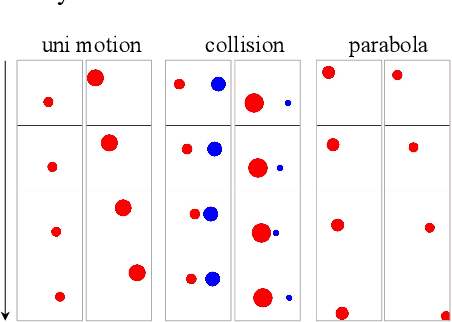

Abstract:OpenAI's Sora highlights the potential of video generation for developing world models that adhere to fundamental physical laws. However, the ability of video generation models to discover such laws purely from visual data without human priors can be questioned. A world model learning the true law should give predictions robust to nuances and correctly extrapolate on unseen scenarios. In this work, we evaluate across three key scenarios: in-distribution, out-of-distribution, and combinatorial generalization. We developed a 2D simulation testbed for object movement and collisions to generate videos deterministically governed by one or more classical mechanics laws. This provides an unlimited supply of data for large-scale experimentation and enables quantitative evaluation of whether the generated videos adhere to physical laws. We trained diffusion-based video generation models to predict object movements based on initial frames. Our scaling experiments show perfect generalization within the distribution, measurable scaling behavior for combinatorial generalization, but failure in out-of-distribution scenarios. Further experiments reveal two key insights about the generalization mechanisms of these models: (1) the models fail to abstract general physical rules and instead exhibit "case-based" generalization behavior, i.e., mimicking the closest training example; (2) when generalizing to new cases, models are observed to prioritize different factors when referencing training data: color > size > velocity > shape. Our study suggests that scaling alone is insufficient for video generation models to uncover fundamental physical laws, despite its role in Sora's broader success. See our project page at https://phyworld.github.io
AdaNAT: Exploring Adaptive Policy for Token-Based Image Generation
Aug 31, 2024



Abstract:Recent studies have demonstrated the effectiveness of token-based methods for visual content generation. As a representative work, non-autoregressive Transformers (NATs) are able to synthesize images with decent quality in a small number of steps. However, NATs usually necessitate configuring a complicated generation policy comprising multiple manually-designed scheduling rules. These heuristic-driven rules are prone to sub-optimality and come with the requirements of expert knowledge and labor-intensive efforts. Moreover, their one-size-fits-all nature cannot flexibly adapt to the diverse characteristics of each individual sample. To address these issues, we propose AdaNAT, a learnable approach that automatically configures a suitable policy tailored for every sample to be generated. In specific, we formulate the determination of generation policies as a Markov decision process. Under this framework, a lightweight policy network for generation can be learned via reinforcement learning. Importantly, we demonstrate that simple reward designs such as FID or pre-trained reward models, may not reliably guarantee the desired quality or diversity of generated samples. Therefore, we propose an adversarial reward design to guide the training of policy networks effectively. Comprehensive experiments on four benchmark datasets, i.e., ImageNet-256 & 512, MS-COCO, and CC3M, validate the effectiveness of AdaNAT. Code and pre-trained models will be released at https://github.com/LeapLabTHU/AdaNAT.
Model Surgery: Modulating LLM's Behavior Via Simple Parameter Editing
Jul 11, 2024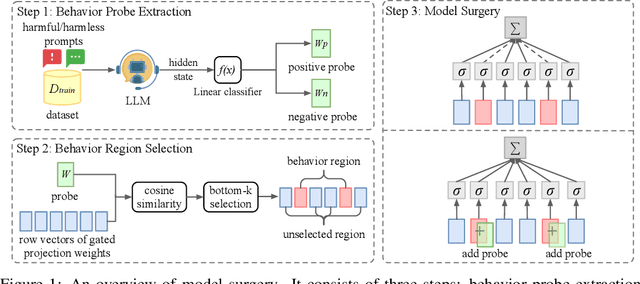


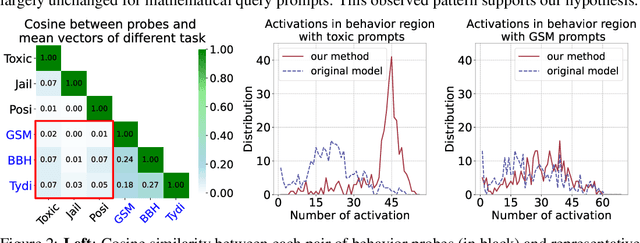
Abstract:Large Language Models (LLMs) have demonstrated great potential as generalist assistants, showcasing powerful task understanding and problem-solving capabilities. To deploy LLMs as AI assistants, it is crucial that these models exhibit desirable behavioral traits, such as non-toxicity and resilience against jailbreak attempts. Current methods for detoxification or preventing jailbreaking usually involve Supervised Fine-Tuning (SFT) or Reinforcement Learning from Human Feedback (RLHF), which requires finetuning billions of parameters through gradient descent with substantial computation cost. Furthermore, models modified through SFT and RLHF may deviate from the pretrained models, potentially leading to a degradation in foundational LLM capabilities. In this paper, we observe that surprisingly, directly editing a small subset of parameters can effectively modulate specific behaviors of LLMs, such as detoxification and resistance to jailbreaking. Specifically, for a behavior that we aim to avoid, we employ a linear classifier, which we term the behavior probe, to classify binary behavior labels within the hidden state space of the LLM. Using this probe, we introduce an algorithm to identify a critical subset of LLM parameters that significantly influence this targeted behavior. Then we directly edit these selected parameters by shifting them towards the behavior probe. Such a direct parameter editing method necessitates only inference-level computational resources. Experiments demonstrate that in the representative detoxification task, our approach achieves reductions of up to 90.0\% in toxicity on the RealToxicityPrompts dataset and 49.2\% on ToxiGen, while maintaining the LLM's general capabilities in areas such as common sense, question answering, and mathematics. Our code is available at https://github.com/lucywang720/model-surgery.
ChatGLM: A Family of Large Language Models from GLM-130B to GLM-4 All Tools
Jun 18, 2024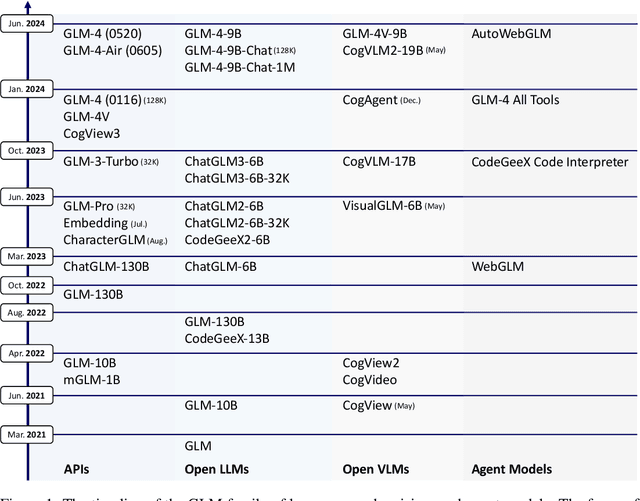
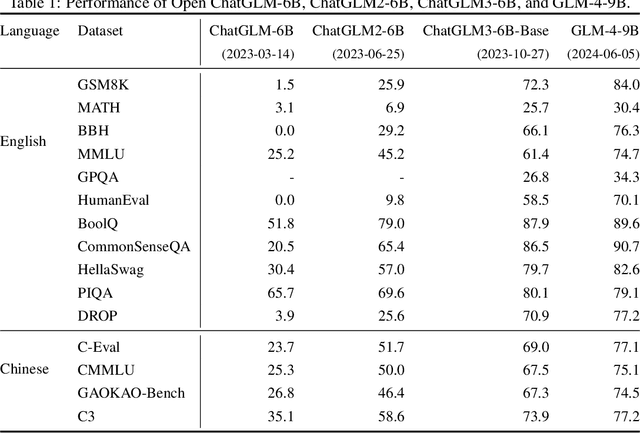
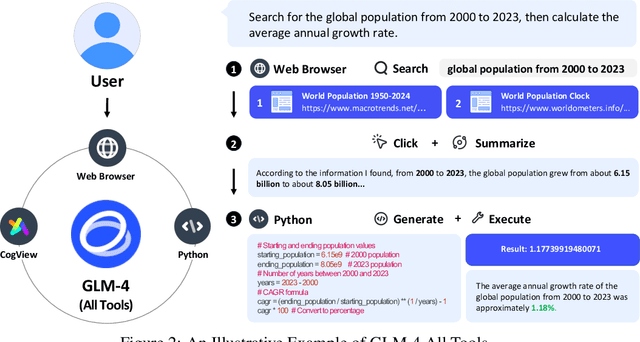
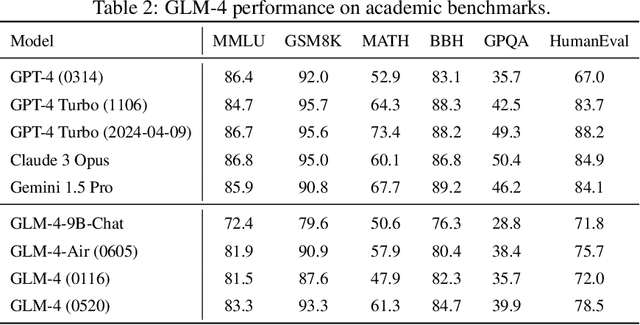
Abstract:We introduce ChatGLM, an evolving family of large language models that we have been developing over time. This report primarily focuses on the GLM-4 language series, which includes GLM-4, GLM-4-Air, and GLM-4-9B. They represent our most capable models that are trained with all the insights and lessons gained from the preceding three generations of ChatGLM. To date, the GLM-4 models are pre-trained on ten trillions of tokens mostly in Chinese and English, along with a small set of corpus from 24 languages, and aligned primarily for Chinese and English usage. The high-quality alignment is achieved via a multi-stage post-training process, which involves supervised fine-tuning and learning from human feedback. Evaluations show that GLM-4 1) closely rivals or outperforms GPT-4 in terms of general metrics such as MMLU, GSM8K, MATH, BBH, GPQA, and HumanEval, 2) gets close to GPT-4-Turbo in instruction following as measured by IFEval, 3) matches GPT-4 Turbo (128K) and Claude 3 for long context tasks, and 4) outperforms GPT-4 in Chinese alignments as measured by AlignBench. The GLM-4 All Tools model is further aligned to understand user intent and autonomously decide when and which tool(s) touse -- including web browser, Python interpreter, text-to-image model, and user-defined functions -- to effectively complete complex tasks. In practical applications, it matches and even surpasses GPT-4 All Tools in tasks like accessing online information via web browsing and solving math problems using Python interpreter. Over the course, we have open-sourced a series of models, including ChatGLM-6B (three generations), GLM-4-9B (128K, 1M), GLM-4V-9B, WebGLM, and CodeGeeX, attracting over 10 million downloads on Hugging face in the year 2023 alone. The open models can be accessed through https://github.com/THUDM and https://huggingface.co/THUDM.
EfficientTrain++: Generalized Curriculum Learning for Efficient Visual Backbone Training
May 14, 2024



Abstract:The superior performance of modern visual backbones usually comes with a costly training procedure. We contribute to this issue by generalizing the idea of curriculum learning beyond its original formulation, i.e., training models using easier-to-harder data. Specifically, we reformulate the training curriculum as a soft-selection function, which uncovers progressively more difficult patterns within each example during training, instead of performing easier-to-harder sample selection. Our work is inspired by an intriguing observation on the learning dynamics of visual backbones: during the earlier stages of training, the model predominantly learns to recognize some 'easier-to-learn' discriminative patterns in the data. These patterns, when observed through frequency and spatial domains, incorporate lower-frequency components, and the natural image contents without distortion or data augmentation. Motivated by these findings, we propose a curriculum where the model always leverages all the training data at every learning stage, yet the exposure to the 'easier-to-learn' patterns of each example is initiated first, with harder patterns gradually introduced as training progresses. To implement this idea in a computationally efficient way, we introduce a cropping operation in the Fourier spectrum of the inputs, enabling the model to learn from only the lower-frequency components. Then we show that exposing the contents of natural images can be readily achieved by modulating the intensity of data augmentation. Finally, we integrate these aspects and design curriculum schedules with tailored search algorithms. The resulting method, EfficientTrain++, is simple, general, yet surprisingly effective. It reduces the training time of a wide variety of popular models by 1.5-3.0x on ImageNet-1K/22K without sacrificing accuracy. It also demonstrates efficacy in self-supervised learning (e.g., MAE).
Augmenting Unsupervised Reinforcement Learning with Self-Reference
Nov 16, 2023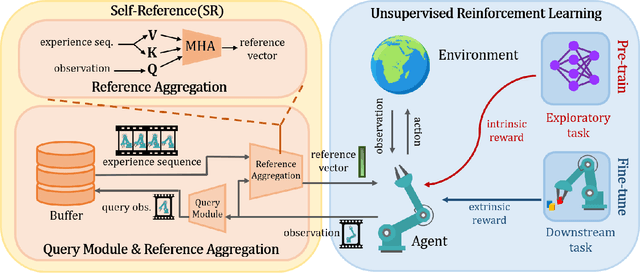
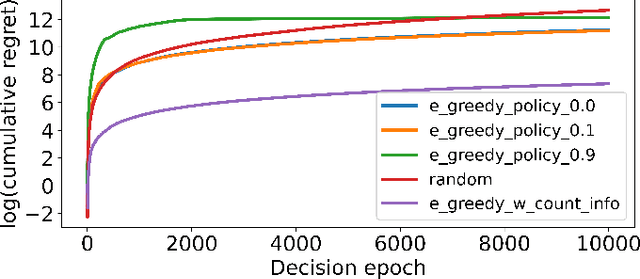
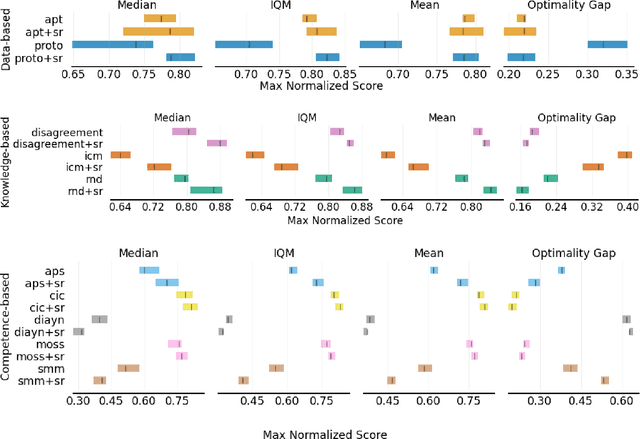
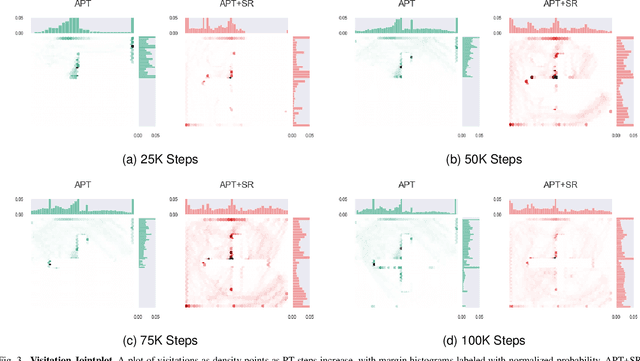
Abstract:Humans possess the ability to draw on past experiences explicitly when learning new tasks and applying them accordingly. We believe this capacity for self-referencing is especially advantageous for reinforcement learning agents in the unsupervised pretrain-then-finetune setting. During pretraining, an agent's past experiences can be explicitly utilized to mitigate the nonstationarity of intrinsic rewards. In the finetuning phase, referencing historical trajectories prevents the unlearning of valuable exploratory behaviors. Motivated by these benefits, we propose the Self-Reference (SR) approach, an add-on module explicitly designed to leverage historical information and enhance agent performance within the pretrain-finetune paradigm. Our approach achieves state-of-the-art results in terms of Interquartile Mean (IQM) performance and Optimality Gap reduction on the Unsupervised Reinforcement Learning Benchmark for model-free methods, recording an 86% IQM and a 16% Optimality Gap. Additionally, it improves current algorithms by up to 17% IQM and reduces the Optimality Gap by 31%. Beyond performance enhancement, the Self-Reference add-on also increases sample efficiency, a crucial attribute for real-world applications.
 Add to Chrome
Add to Chrome Add to Firefox
Add to Firefox Add to Edge
Add to Edge